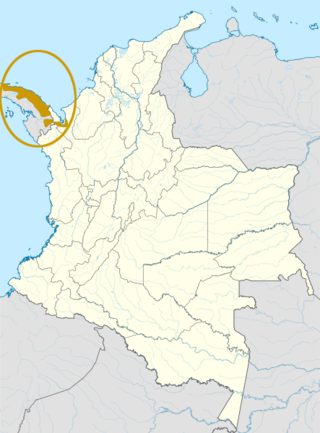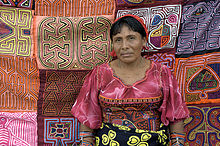Kuna language
| Kuna | |
|---|---|
| Dulegaya | |
| Native to | Panama,Colombia |
| Region | San Blas Islands,Panama;north coastal region,Colombia |
| Ethnicity | Kuna people |
Native speakers | 61,000 (2000)[1] |
Chibchan
| |
| Language codes | |
| ISO 639-3 | Either:cuk– San Blas Kunakvn– Border Kuna |
| Glottolog | kuna1280 |
| ELP | Kuna |
 | |

TheKuna language(formerlyCuna,and in the language itselfGuna), spoken by theKuna peopleofPanamaandColombia,belongs to theChibchan language family.
History
[edit]The Kuna were living in what is now Northern Colombia and theDarién Provinceof Panama at the time of the Spanish invasion, and only later began to move westward towards what is nowGuna Yaladue to a conflict with Spanish and other indigenous groups. Centuries before the conquest, the Kuna arrived inSouth Americaas part of aChibchanmigration moving east fromCentral America.At the time of the Spanish invasion, they were living in the region of Uraba and near the borders of what are nowAntioquiaandCaldas.Alonso de OjedaandVasco Núñez de Balboaexplored the coast of Colombia in 1500 and 1501. They spent the most time in theGulf of Urabá,where they made contact with the Kuna.
In far-eastern Guna Yala, the community of New Caledonia is near the site whereScottishexplorers tried, unsuccessfully, to establish acolony in the "New World".The bankruptcy of the expedition has been cited as one of the motivations of the1707 Acts of Union.
There is a wide consensus regarding the migrations of Kuna from Colombia and the Darien towards what is now Guna Yala. These migrations were caused partly by wars with theCatio people,but some sources contend that they were mostly due to bad treatment by the Spanish invaders. The Kuna themselves attribute their migration to Guna Yala to conflicts with the native peoples, and their migration to the islands to the excessive mosquito populations on the mainland.
During the first decades of the twentieth century, the Panamanian government attempted to suppress many of the traditional customs. This was bitterly resisted, culminating in a short-lived yet successful revolt in 1925 known as theTule Revolution(or people revolution), led byIguaibilikinyah Nele GantuleofUstupuand supported by American adventurer and part-time diplomatRichard Marsh[2]– and a treaty in which the Panamanians agreed to give the Kuna some degree of cultural autonomy.[2]
Phonemes
[edit]Kuna language recognizes 5vowelphonemesand 17consonantalphonemes.
Vowels
[edit]| Front | Central | Back | |
|---|---|---|---|
| High | i | u | |
| Mid | e | o | |
| Low | a |
Vowels may be short or long.
Consonants
[edit]| Labial | Alveolar | Palatal | Velar | ||
|---|---|---|---|---|---|
| Plosive | Lax | p⟨b⟩ | t⟨d⟩ | k⟨g⟩ | |
| Tense | pː⟨bb⟩ | tː⟨dd⟩ | kː⟨gg⟩ | ||
| Nasal | Lax | m⟨m⟩ | n⟨n⟩ | ||
| Tense | mː⟨mm⟩ | nː⟨nn⟩ | |||
| Affricate | tʃ⟨ds, ss⟩ | ||||
| Fricative | s⟨s⟩ | ||||
| Lateral | Lax | l⟨l⟩ | |||
| Tense | lˑ⟨ll⟩ | ||||
| Rhotic | ɾ⟨r⟩ | ||||
| Approximants | w⟨w⟩ | j⟨y⟩ | |||
Most consonants may appear either as short (lax) or long (tense). The long consonants only appear in intervocalic position. However, they are not always a result of morpheme concatenation, and they often differ phonetically from the short analogue. For example, the long stop consonants p, t, and k are pronounced as voiceless, usually with longer duration than in English. The short counterparts are pronounced as voiced b, d, and g when they are between vowels or besidesonorantconsonants m, n, l, r, y, or w (they are written using b, d, and g in the Kuna alphabet). At the beginnings of words, the stops may be pronounced either as voiced or voiceless; and are usually pronounced as voiceless word-finally (Long consonants do not appear word-initially or word-finally). In an even more extreme case, the long s is pronounced [tʃ]. Underlying long consonants become short before another consonant. The letterwmay be pronounced as either [v] or [w] depending on dialect and position.
In 2010, the National Kuna Congress decided a spelling reform by which long consonants should be written with double letters. Equally, the phonemes /p, t, k/ that may sound like [p, t, k] or [b, d, g] are represented by⟨b, d, g⟩in all positions. Equally, the old digraph⟨ch⟩becomes⟨ss⟩or⟨ds⟩depending on its morphological precedence (narassole [naraʧole] < naras + sole, godsa [koʧa] 'called' < godde 'to call' + -sa (past). So, the reformed orthography uses only the fifteen letters⟨b, d, g, l, m, n, r, s, w, y; a, e, i, o, u⟩for transcribing all the sounds of the language, with the digraphs⟨bb, dd, gg, ll, mm, nn, ss⟩for the tense consonants.[3]
Other phonological rules
[edit]The alveolar /s/ becomes the postalveolar [ʃ] after /n/ or /t/. Both long and short /k/ become [j] before another consonant.
Morphology
[edit]Kuna is anagglutinative languagewhich contains words of up to about 9 morphemes, although words of two or three morphemes are more common. Most of the morphological complexity is found in the verb, which contains suffixes of tense and aspect, plurals, negatives, position (sitting, standing, etc.) and various adverbials. The verb is not marked for person.
References
[edit]- ^San Blas KunaatEthnologue(24th ed., 2021)

Border KunaatEthnologue(24th ed., 2021)
- ^abJames Howe.A PEOPLE WHO WOULD NOT KNEEL: Panama, the United States, and the San Blas Kuna(Smithsonian Series in Ethnographic Inquiry). Smithsonian, 1998.ISBN978-1-56098-865-6
- ^"Archived copy"(PDF).www.congresogeneralkuna.com.Archived fromthe original(PDF)on 6 February 2012.Retrieved13 January2022.
{{cite web}}:CS1 maint: archived copy as title (link)
Further reading
[edit]- Llerena Villalobos, Rito. (1987).Relación y determinación en el predicado de la lengua Kuna.Bogotá: CCELA – Universidad de los Andes. ISSN 0120-9507(in Spanish)
- Alphonse Louis Pinart (1890).Vocabulario castellano-cuna.Ernest Leroux. pp.3–.Retrieved25 August2012.
- Holmer, Nils Magnus (1952).Ethno-linguistic Cuna dictionary, with indices and references to A critical and comparative Cuna grammar (Etnologiska studier 14) and The grammatical sketch in Cuna chrestomathy (Etnologiska studier 18).Göteborg: Etnografiska Museet.
- de Gerdes, Marta Lucía. (2003). "'The life story of grandmother Elida': Kuna personal narratives as verbal art." In Translating native Latin American verbal art: Ethnopoetics and ethnography of speaking. Kay Sammons and Joel Sherzer, eds. Washington, D.C
- Wikaliler Daniel Smith. 2014.A Grammar of Guna: A Community-Centered Approach.University of Texas at Austin.
External links
[edit]- Kuna phrasebook
- Vocabulario Castellano-Cuna: Compuesto por el Señor Don Alfonso L. Pinart
- Kuna language,Archive of the Indigenous Languages of Latin America
- OLAC resources in and about the San Blas Kuna language
- ELAR archive ofDocumentation and Description of Kuna
- Kuna Collection of Marta Lucía de Gerdes,including recordings and translations of a narrative and a chant, from theArchive of the Indigenous Languages of Latin America.
- Gammibe Gun Galu,an archive of recordings of a Kuna musical group, from theArchive of the Indigenous Languages of Latin America.
